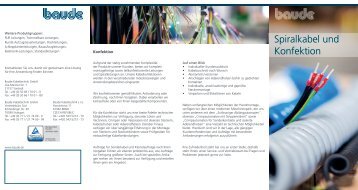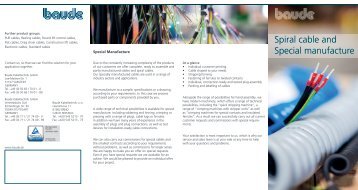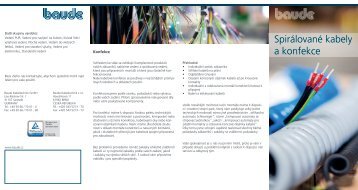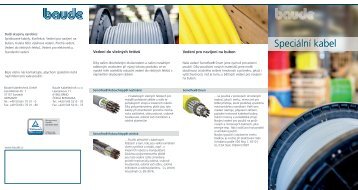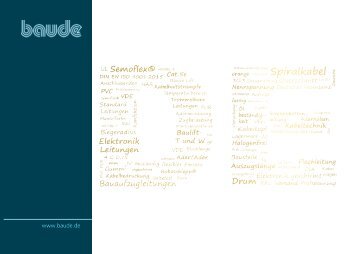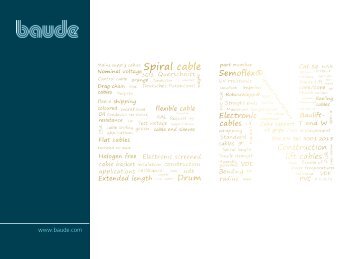Baude Produktkatalog
- Text
- Kabelhersteller
- Flexiblekabel
- Kabeldurchmesser
- Spiralkabel
- Kabel
- Cables
- Outer
- Conductor
- Flexible
- Semoflex
- Sheath
- Technical
- Cores
- Diameter
- Insulation
Der Baude Produktkatalog 2021 bietet Einblick in das aktuelle Produktsortiment.
Sie können unseren Kabel und Leitungen Katalog bequem und einfach auf sämtlichen Geräten online ansehen. Egal ob am festen Arbeitsplatz-Computer, bequem auf dem Sofa mit Tablet oder mobil mit dem Smartphone.
Sie möchten in aller Ruhe unseren aktuellen Katalog durchblättern?
Sehr gern senden wir Ihnen unseren aktuellen Produktkatalog oder unser Prospekt für Spiral- und/oder Spezialkabel gratis und bequem per Post zu.
Semoflex ® Roboschlepp
Semoflex ® Roboschlepp ® Flachleitungen Flat cables Montagerichtlinien • Leitungstrommeln mit Transporthilfsmitteln zum Einsatzort bringen, nur im Sonderfall rollen. • Bewegungsrichtung immer entgegengesetzt der Abwickelrichtung der Leitungen. • Lagerung der Leitungstrommeln nur stehend, im Freien mit Abdeckung. • Leitungstrommeln beim Abwickeln nicht zu stark abbremsen. • Biegerichtung gleich Wickelrichtung der Trommel bzw. des Ringes. • Abbinden der Ringe mit mind. 15 mm breiten Textilbändern oder gleichwertigem Material (ggf. PVC-Band). • Leitungsringe während des Transportes und auf der Baustelle vor Deformationen schützen und flach lagern. • Leitungen radial vom Ring abziehen oder von der Trommel direkt in die Anlage abrollen, nicht S-förmig (Drallfrei) oder in eine andere Ebene vorher umlenken, nicht über den Boden schleifen. • Leitungsmontagen nicht bei Temperaturen unter - 25 °C vornehmen. Leitungsmontage in Energieführungsketten • Für den Einbau in Energieführungsketten sind möglichst flexible Leitungen des Typs Semoflex ® Roboschlepp mit Semocore zwecks Vermeidung von Litzenbrüchen im Einsatz, zu verwenden. • Der Mindestbiegeradius der Leitung von 7,5 mal Leitungsdurchmesser darf nicht unterschritten werden. • Beim Einbau ist darauf zu achten, dass die Leitungen drallfrei von der Trommel abgezogen und ebenso in die Führungskette eingelegt werden. Leitungen dürfen nicht seitlich von Trommeln oder Ringen entnommen werden. • In der Führungskette müssen sich die Leitungen spannungsfrei in Längsrichtung bewegen können und den Kettenbogen mit Abstand zur Vermeidung von Zugbeanspruchung umlaufen können. • Leitungen sollten möglichst lose durch Stege getrennt nebeneinander in den einzelnen Profilen oder Bohrungen angeordnet werden. Der Freiraum der Leitungen untereinander sollte mindestens 10% des Leitungsdurchmessers betragen. Bündelungen, Übereinanderlegen oder Befestigen von Leitungen ist nicht zulässig. Auch sollten die eingesetzten Leitungen auf 25 Adern begrenzt werden und darüber hinaus auf mehrere Leitungen aufgeteilt werden. • Bei Einbau von mehreren Leitungen in eine Führungskette sollte auf eine gleichmäßige Gewichtsverteilung geachtet werden und Leitungen mit dem größten Gewicht nach außen verlegt werden. • Leitungen müssen immer an einer Seite der Führungskette an einem nicht bewegtem Teil befestigt werden und bei Verfahrwegen > 5 m an beiden Seiten. • Eine Kontrolle nach einer kurzen Einlaufzeit der verlegten Leitungen in der Führungskette sollte immer durchgeführt werden, um eventuelle Verlegefehler zu korrigieren. Installation instructions • The delivered cable drum should be moved by suitable lifting equipment to the building site. The cable should not be rolled, only in exceptional circumstances. • Moving direction of the cable drum should be opposite to the uncoiled direction. • Cable drums should be stored vertically, the drums should be covered if stocked outdoors. • When coiling from drums you should not stop the drum suddenly. • The bending direction corresponds to the winding direction of drum/coil. • The coils of cable should be fitted with 2 of minimum 15 mm wide textile tape or similar materials (eventually PVC tapes). • During transit the cable coils should be protected on building sites against deformation, the cable should be stocked flat. • If the cable is delivered as coils you should pull down the cable radially or the cable should be rolled off directly from the drum to the plant. Do not turn round the cable in an S-form or in another direction. Do not drag the cable along the ground. • The installation of the cable should not be carried out if temperatures are lower than - 25 °C. Instructions for cable installation in power drag chains • For the installation in power chains the most flexible cables type Semoflex ® Roboschlepp with Semocore should be used in order to avoid any wire breaks. • The bending radius should not fall below the smallest admissible bending radius of 7,5 x cable diameter. • During their installation the cables must be uncoiled from the drum twist-free and inserted also twist-free in the drag chain. Cables should not be uncoiled laterally from the drums or rings. • In the guide chain the cables must move tensile-free in the longitudinal direction and go round in the chain arch at a certain distance to the chain to avoid any tensile stresses. • Cables should be arranged as loose cables separated by bridges and side by side in the single profiles or holes. The free space between single cables should amount at least 10% of the cable diameter. Bundles, superposing and fixations of cables are not allowed. The number of cores of the used cables should not exceed 25 cores and moreover should be allocated on several cables. • During the installation of several cables in the drag chain the weight of the cables must be equally distributed and the cables featuring the biggest weight should be laid at both inner sides of the drag chain. • Cables should always be fixed at parts of the drag chains that are not moved. By travelling distances > 5 meters, a fixation at both sides is required. Montagerichtlinien • Nachdem die Leitungswagen in der benötigten Anzahl auf die Schiene gesetzt und im nötigen Abstand im Bahnhof platziert wurden, ist zu beachten, dass der Abstand zwischen zwei Leitungswagen größer ist als die Dicke zweier Leitungspakete. • Das Auflegen der Leitung auf der Auflagefläche des Leitungswagen beginnt mit der schwächsten und dünnsten Leitung des Paketes. • Bei einer Paketierung über- und nebeneinander ist die Rangfolge der Leitung wie zuvor beschrieben vorzunehmen. Es ist jedoch zusätzlich auf eine gleichmäßige Verteilung auf dem Leitungswagen zu achten. • Bevor das Leitungspaket auf dem Leitungswagen mit Hilfe der entsprechenden Schrauben festgezogen wird, müssen die Leitungen in der Schlaufe so ausgerichtet werden, dass an der tiefsten Stelle der Schlaufe ein Abstand zwischen den einzelnen Leitungen von mindestens 6 mm besteht. • Innerhalb der Schlaufen des Leitungspaketes ist ein Zusammenbinden oder Verkleben der Leitungen zu vermeiden, da es sonst unweigerlich zu Aderbrüchen aufgrund auftretender Stauchungen kommen kann. • Bei großen Schlaufentiefen, hohen Verfahrgeschwindigkeiten der Anlage oder bei möglicherweise starkem Windeinfall sind sogenannte Gitterklemmen zu verwenden. Gitterklemmen werden an der schwersten Leitung 2-fach rechts und links ca. 1/3 vom Mittelpunkt entfernt befestigt, während alle anderen lose in der Klemme geführt werden sollten. • Bei Leitungspaketen die nur aus Steuerleitungen bestehen, wird empfohlen, eine oder zwei Leitungen in der obersten Lage mit Zugentlastungselemente zu verwenden. Dies gilt insbesondere bei Anlagen, deren Fahrgeschwindigkeiten größer 60 m/min oder Beschleunigungen größer 0,5 m/s sind. Installation instructions • After placing the required quantity of trolleys on the rail at the required distance of the station, it is important that the distance between two trolleys is larger than the thickness of two stacks of cables • The installation of the cable on the supporting surface of the trolley begins with the weakest and finest cable of the stack • By packing over and beside, you have to ensure the order of cables as described before. You also should ensure the equal distribution at the trolley • Before the stack of cables is fixed on the trolley with help of special screws, the cables should be adjusted into a loop so that at the deepest point of the loop is a clearance between each cable of 6mm for minimum • Within the loops of the stack of cables have to be avoided a tie up or a conglutination of cables because otherwise could appear possibly breaks of cores caused by upsetting deformations • For loop depths high running speeds of the machine or possible strong winds suchs as loop clamps have to be used. Loop clamps should be fixed right and left side at the heaviest cable in a distance of about 1/3 from the central point while all the other cables should be leaded loosely in the clamp • For cable stacks which only consist of control cables, it is recommended to use one or two cables in the highest layer with central carrier elements. In particular this is relevant for machines with running speeds of more than 60m/sec. or acceleration of more than 0,5m/sec. • After a short initial running of the laid cables in the drag chain a control should be carried out in order to correct possible installation errors. ➔ Technische Änderungen vorbehalten. ➔ Technische Änderungen vorbehalten. 174 Subject to technical changes without notification. Subject to technical changes without notification. 175
- Seite 1 und 2:
Zukunftslösungen für flexible Kab
- Seite 4:
Inhaltsverzeichnis Index 4 22 40 11
- Seite 8:
3 Semoflex ® H05BQ-F, H07BQ-F Die
- Seite 12:
4 Semoflex ® Elektronik Die PUR-Le
- Seite 16:
6 Semoflex ® Special Industrial Et
- Seite 20:
Geschirmte PVC Elektronikleitung Sc
- Seite 24:
2 Spiralkabel Spiral cables Spiralk
- Seite 28:
Spiralkabel Spiral cables Semoflex
- Seite 32:
Spiralkabel Spiral cables Semoflex
- Seite 36:
Spiralkabel Spiral cables Semoflex
- Seite 40:
Spiralkabel Spiral cables PVC H05VV
- Seite 44:
Kabelkonfektion Cable assembly indi
- Seite 48:
Semoflex ® H05BQ-F / H07BQ-F Netza
- Seite 52:
4 Trommelbare Leitungen & Zubehör
- Seite 56:
Semoflex ® Drum 0,6 / 1 KV halogen
- Seite 60:
Kabelhaltestrümpfe Cable support g
- Seite 64:
HSTN HSTCN Neoprene Rundleitung mit
- Seite 68:
4 Baude-Lift-2TY Kranleitung mit 2
- Seite 72:
SemoFlat ® H05VVH6-F PVC Flachleit
- Seite 76:
6 Flachleitungen Flat cables SemoFl
- Seite 80:
SemoFlat ® H07VVH6-F PVC Flachleit
- Seite 84:
HKYFLCY-Bd, HKYFLTCY-Bd, HKYFLTFY-B
- Seite 88:
HFLCN Neoprene Flachleitung einzeln
- Seite 92:
7 Schleppkettenleitungen Drag chain
- Seite 96:
Semoflex ® Roboschlepp ® halogenf
- Seite 100:
4 4 Semoflex ® Roboschlepp ® gesc
- Seite 104:
Semoflex ® D-PVC Die PVC-Leitung f
- Seite 108:
PP/PUR Schleppkettenleitung Drag ch
- Seite 112:
8 Bauaufzugleitungen & Zubehör Con
- Seite 116:
Kabelhaltestrümpfe Cable support g
- Seite 120:
LiYY Flexible Elektronikleitung Fle
- Seite 124: 5 LiYCY Flexible Elektronikleitung
- Seite 128: LiYCY/CY Flexible Elektronikleitung
- Seite 132: 10 Standardleitungen Standard cable
- Seite 136: HYSLY Flex -JZ Flexible PVC-Maschin
- Seite 140: HYSLCY grau grey Flexible PVC-Masch
- Seite 144: 5 HYSLY-SY-JZ transparent Flexible
- Seite 148: 5 HYSLYCY 0,6/1 kV schwarz black Fl
- Seite 152: 2YSLCY-J 0,6/1kV transparent PVC Mo
- Seite 156: NSSHÖU Schwere Gummischlauchleitun
- Seite 160: SiHF-J Flexible hochwärmebeständi
- Seite 164: RG Koaxialkabel Coaxial cable In An
- Seite 168: 11 Technische Daten & Montagerichtl
- Seite 172: Semocore Semoflex ® Drum Aderisola
- Seite 178: Runde Aufzugsteuerleitungen Round l
- Seite 182: Semoflex ® Baulift-W Spezial Einsa
- Seite 186: Aderfarbfolge nach DIN 47100 1 wei
- Seite 190: Belastbarkeit, Leitungen mit Nennsp
- Seite 194: Leiterwiderstand Flexible Leiter (K
- Seite 198: Kleinste zulässige Biegeradien Low
- Seite 202: Kupferberechnung Copper calculation
- Seite 206: Allgemeine Geschäftsbedingungen f
- Seite 210: IMPRESSUM IMPRINT Herausgeber: Baud
Unangemessen
Laden...
Magazin per E-Mail verschicken
Laden...
Einbetten
Laden...
Flyer
INFORMATIONEN
KONTAKT
Baude Kabeltechnik GmbH
Lise-Meitner-Str. 1
31157 Sarstedt
Deutschland
Telefon: +49 5066 7001-0
Telefax: +49 5066 7001-80



